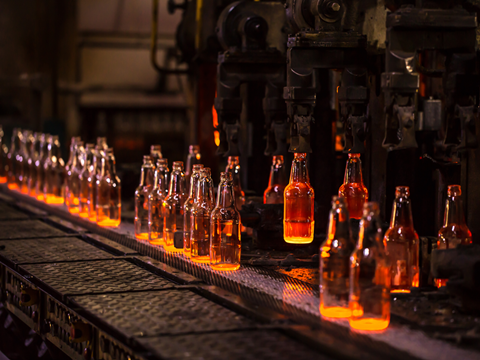
With our 2020 Sustainability Awards just three days away, we spoke with one of the finalists, Ardagh Group, about its innovative method for giving a new life to glass that is rejected during the recycling process.
Congratulations on being selected by the international judging panel as a Sustainability Awards 2020 finalist! Could you please introduce your successful entry and what’s innovative about it?
Ardagh Group has developed a method to produce briquettes from the fine particle glass rejected during the recycling process, allowing 100% of recycled glass to be remelted into new bottles and jars.
The goal of the project was to maximise cullet recovery for remelt, focusing on the small particles of glass breakage, or “fines”, caused during collection or produced during the recycling process itself.
These fines make up 10% of glass collected for recycling and are currently unusable in glass manufacture, because they contain excessive amounts of Loose Organics and CSP (ceramic, stone, and porcelain) which can create problems if they enter the furnace for remelt, causing blistering and inclusions in new containers.
Fines are typically diverted into road aggregate production or lost to landfill and will never be recovered for remelt: a “cradle to grave” scenario.
Our research and development has culminated in the design of a processing plant to close the recycling loop by creating briquettes using 100% of recycled glass containers recovered through the various collection systems across the UK. The plant will be the first commercial type in the world.
Cullet is Ardagh’s most important raw material for making new glass containers. For many years, we have led various initiatives to increase the percentage of cullet used in our batch recipes, as an integral part of our Group Sustainability Strategy. The quality of the cullet is critical.
To this end, we embarked on the journey to recover the fines with a series of trials to process and reconstitute them into a usable commodity in glass remelting without the negative effects.
18 laboratory experiments were undertaken to determine the optimum fraction size through milling the infeed, and find a suitable binding agent, to finally develop a format with the right physical properties. We achieved a breakthrough in producing briquettes that were chemically and physically suitable for remelt, performed well in trials, and had no adverse effect on the furnace or on the finished product.
The next phase was to achieve a more robust briquette with the physical properties to be transported, handled, and stored without deterioration. The resulting briquettes were then subjected to various tests: immersion in water, compression testing, drop testing, and High Temperature Observation Studies (HTMOS) and performed excellently.
We are now advancing the project and planning to construct an industrial scale briquette plant.
What are the environmental challenges in packaging that your entry addresses, and what impact do you hope it will make?
The whole glass packaging value chain is continually developing ways to reduce the emissions and environmental impact of glass manufacture. Using the briquettes to increase the cullet ratio in the glass batch recipe will reduce the need for raw materials, reducing energy consumption and CO2 emissions in the furnace, improving the circularity and thus the environmental impact of glass packaging.
The additional cullet available as briquettes will help to achieve the ultimate objective of 95% cullet and 5% raw materials within the glass batch.
I’d like to ask you about the broader picture beyond your successful entry. ‘Sustainability’ in packaging is multi-dimensional – both in terms of objectives and challenges. Could you comment on the most important roadblocks you identify from your position in the value chain, and the kinds of solutions you would like to see addressing them (e.g. areas of technological innovation, collaboration, regulation)?
Sustainability has been a strategic imperative at Ardagh for many years, and our Sustainability Strategy targets every area of the business. We have already achieved an incredible amount and are continually working on the important issue of reducing the amount of CO2 emissions from glass production.
Industry-wide collaboration projects, such as the hybrid, oxy-fuel Furnace of the Future, are vital: sharing expertise and resources to replace fossil-fuel energy sources and cut CO2 emissions, to make glass production more sustainable throughout the world.
We would like to see more switching to renewable energy and improved energy efficiency of existing glass melting furnaces, processes, and plants as a whole, and more process innovation. Waste heat recovery through innovative technology such as Organic Rankine Cycle Engines is an important step in saving energy in the furnace by preheating the batch.
As a member of the container glass federation, FEVE, Ardagh is fully behind the ’Close the Glass Loop’ campaign, which aims to increase the amount of recycled glass collection from 76% to 90% across Europe which, again, will increase the glass cullet available for remelt, reducing energy and emissions in the furnace.














